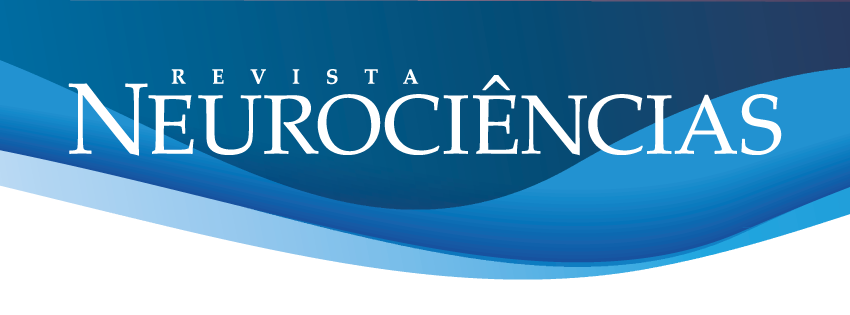Disfunções olfativas e complicações neurológicas em pacientes com COVID-19
DOI:
https://doi.org/10.34024/rnc.2024.v32.15140Palavras-chave:
COVID-19, Anosmia, Olfato, Manifestações NeurológicasResumo
Introdução. Casos de pneumonia de etiologia desconhecida, mas com características semelhantes a um quadro viral, foram identificados na China no final de 2019. Pesquisadores constataram o coronavírus da síndrome respiratória aguda grave 2 como o causador dessa infecção, a qual foi denominada COVID-19. A COVID-19 pode estar associada à injúria cerebral. Dois mecanismos de chegada do vírus até o cérebro: via hematogênica e disseminação neuronal retrógrada, esta envolve o sistema olfatório. Os distúrbios olfativos podem indicar injúria cerebral e associação com complicações neurológicas. Objetivos. Analisar a associação entre disfunções olfativas e complicações neurológicas na COVID-19. Método. Estudo retrospectivo observacional. Resultados. Foram avaliados 989 prontuários. Comorbidades mais prevalentes: hipertensão arterial sistêmica (47,3%), diabetes mellitus (25,2%) e dislipidemia (24,2%). Sintomas mais prevalentes: cefaleia (22,3%), astenia (15,5%), anosmia (8,3%), ageusia (5,0%). Presença de AVC prévio foi preditor de morte, 52% desses pacientes evoluíram para óbito. Cefaleia, anosmia e/ou ageusia foram preditoras de quadro mais leve, visto que 14%, 10,2% e 10,2% evoluíram para óbito, respectivamente. Rebaixamento do nível de consciência (RNC), confusão mental e AVC durante o internamento foram preditores de óbito, visto que, respectivamente, 54,5%, 70% e 60% dos pacientes evoluíram para óbito. Conclusão. Presença de AVC prévio, RNC, confusão mental e Acidente Vascular Cerebral durante o internamento foram preditores de óbito. Anosmia, ageusia e cefaleia foram relacionadas a desfechos favoráveis.
Métricas
Referências
Lu H, Stratton CW, Tang YW. Outbreak of pneumonia of unknown etiology in Wuhan, China: The mystery and the miracle. J Med Virol 2020;92:401–2. https://doi.org/10.1002/jmv.25678
Mao L, Jin H, Wang M, Hu Y, Chen S, He Q, et al. Neurological Manifestations of Hospitalized Patients with COVID-19 in Wuhan, China: a retrospective case series study. JAMA Neurol 2020;77:683-90. https://doi.org/10.1001/jamaneurol.2020.1127
Huang C, Wang Y, Li X, Ren L, Zhao J, Hu Y, et al. Clinical features of patients infected with 2019 novel coronavirus in Wuhan, China. Lancet 2020;395:497-506. https://doi.org/10.1016/S0140-6736(20)30183-5
Hess DC, Eldahshan W, Rutkowski E. COVID-19-Related Stroke. Translat Stroke Res 2020;11:322-5. https://doi.org/10.1007/s12975-020-00818-9
Ahmed MU, Hanif M, Ali MJ, Haider MA, Kherani D, Memon GM, et al. Neurological Manifestations of COVID-19 (SARS-CoV-2): A Review. Front Neurol 2020;11:518. https://doi.org/10.3389/fneur.2020.00518
Turner AJ, Hiscox JA, Hooper NM. ACE2: From vasopeptidase to SARS virus receptor. Trends Pharmacol Sci 2004;25:291-4. https://doi.org/10.1016/j.tips.2004.04.001
Politi LS, Salsano E, Grimaldi M. Magnetic Resonance Imaging Alteration of the Brain in a Patient With Coronavirus Disease 2019 (COVID-19) and Anosmia. JAMA Neurol 2020;77:1028-9. https://doi.org/10.1001/jamaneurol.2020.2125
Jose RJ, Manuel A. COVID-19 cytokine storm: the interplay between inflammation and coagulation. Lancet Respir Med 2020;8:e46-7. https://doi.org/10.1016/S2213-2600(20)30216-2
Mao L, Jin H, Wang M, Hu Y, Chen S, He Q, et al. Neurologic Manifestations of Hospitalized Patients With Coronavirus Disease 2019 in Wuhan, China. JAMA Neurol 2020;77:683-90. https://doi.org/10.1001/jamaneurol.2020.1127
Li S-R, Tang Z-J, Li Z-H, Liu X. Searching therapeutic strategy of new coronavirus pneumonia from angiotensin-converting enzyme 2: the target of COVID-19 and SARS-CoV. Eur J Clin Microbiol Infec Dis 2020;39:1021. https://doi.org/10.1007/s10096-020-03883-y
Bergmann CC, Lane TE, Stohlman SA. Coronavirus infection of the central nervous system: host-virus stand-off. Nat Rev Microbiol 2006;4:121-32. https://doi.org/10.1038/nrmicro1343
Wang K, Chen W, Zhou YS, Lian JQ, Zhang Z, Du P, et al. SARS-CoV-2 invades host cells via a novel route: CD147-spike protein. BioRxiv 2020;2020:1-10. https://doi.org/10.1101/2020.03.14.988345
Cantuti-Castelvetri L, Ojha R, Pedro LD, Djannatian M, Franz J, Kuivanen S, et al. Neuropilin-1 facilitates SARS-CoV-2 cell entry and infectivity. Science 2020;370:856-60. https://doi.org/10.1126/science.abd2985
Shang J, Wan Y, Luo C, Ye G, Geng Q, Auerbach A, et al. Cell entry mechanisms of SARS-CoV-2. Proc Natl Acad Sci USA 2020;117:11727. https://doi.org/10.1073/pnas.2003138117
Iadecola C, Anrather J, Kamel H. Effects of COVID-19 on the Nervous System. Cell 2020;183:16-27. https://doi.org/10.1016/j.cell.2020.08.028
Zhou Z, Kang H, Li S, Zhao X. Understanding the neurotropic characteristics of SARS-CoV-2: from neurological manifestations of COVID-19 to potential neurotropic mechanisms. J Neurol 2020;267:2179-84. https://doi.org/10.1007/s00415-020-09929-7
Sarin H. Physiologic upper limits of pore size of different blood capillary types and another perspective on the dual pore theory of microvascular permeability. J Angiogenes Res 2010;2:14. https://doi.org/10.1186/2040-2384-2-14
Nampoothiri S, Sauve F, Ternier G, Fernandois D, Coelho C, Imbernon M, et al. The hypothalamus as a hub for SARS-CoV-2 brain infection and pathogenesis. BioRxiv 2020;2020:1-46. https://doi.org/10.1101/2020.06.08.139329
Erickson MA, Banks WA. Neuroimmune Axes of the Blood-Brain Barriers and Blood-Brain Interfaces: Bases for Physiological Regulation, Disease States, and Pharmacological Interventions. Pharmacol Rev 2018;70:278-314. https://doi.org/10.1124/pr.117.014647
Diao B, Wang C, Tan Y, Chen X, Liu Y, Ning L, et al. Reduction and Functional Exhaustion of T Cells in Patients With Coronavirus Disease 2019 (COVID-19). Front Immunol 2020;11:827. https://doi.org/10.3389/fimmu.2020.00827
Bryce C, Grimes Z, Pujadas E, Ahuja S, Beasley MB, Albrecht R, et al. Pathophysiology of SARS-CoV-2: targeting of endothelial cells renders a complex disease with thrombotic microangiopathy and aberrant immune response. The Mount Sinai COVID-19 autopsy experience. MedRxiv 2020;2020:1-24. https://doi.org/10.1101/2020.05.18.20099960
Oxley TJ, Mocco J, Majidi S, Kellner CP, Shoirah H, Singh IP, et al. Large-Vessel Stroke as a Presenting Feature of Covid-19 in the Young. N Engl J Med 2020;382:e60. https://doi.org/10.1056/NEJMc2009787
Lodigiani C, Iapichino G, Carenzo L, Cecconi M, Ferrazzi P, Sebastian T, et al. Venous and arterial thromboembolic complications in COVID-19 patients admitted to an academic hospital in Milan, Italy. Thromb Res 2020;191:9-14. https://doi.org/10.1016/j.thromres.2020.04.024
Downloads
Publicado
Edição
Seção
Licença
Copyright (c) 2024 Isabella Cristina Mendes Rossa, Rebecca Benicio Stocco, Marcos Roberto Curcio Pereira, Maria Fernanda Braga Vilacio Pinto, Mariana de Oliveira Trintinalha, Carlos Alexandre Twardowschy

Este trabalho está licenciado sob uma licença Creative Commons Attribution 4.0 International License.
Como Citar
Aprovado 2023-12-21
Publicado 2024-01-12


